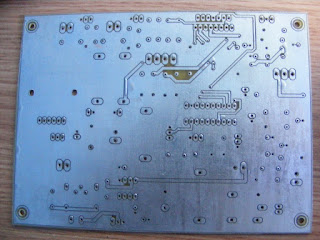I start working and i have established a first direction.
I use:
1. PIC16F876 controller
2. engine temperature sensor
3. TPS - throttle position sensor
4. lambda probe (oxygen sensor)
5. engine speed and position will be read from the ignition coil (negative connector).
Connected to the controller will be a 16x2 LCD display.
The first test looks like this:
PIC16F876:
- RISC CPU
- max 20MHz
- 8K program memory
- 368 bytes RAM
- 256 bytes EEPROM
- 5 analogic input
- 17 digital I/O At that time I considered enough the above configuration.
So I connected the LCD in 8bit mode (11 digital pins), I put a 2
buttons (another 2 digital pins), two entries for the two signals from the
coils, and two outputs for the two injectors. In total 17 digital ports
occupied. I tested with a temperature sensor (termistor) => tests were a success. LCD's work correctly, A/D converters works well ... everything was OK.
At that time did not know of the two EFI systems, ALPHA-N and SpeedDendity. For simplicity i choose to calculate the injector timing from engine speed and throttle position (ALPHA-N type system).
I intend that all the systems (controller, LCD, the power block and the sensors) to fit in place of one of the two watches on-board.
For simulating and design the pcb i used a series of software in their demo version but most easily to use was "
Circuit Simulator Applet".
You can see in the picture bellow some stages of the design.
The scheme contains:
- two entries for the signals from coils, each controlled by one transistor BC547
- an LM7805 voltage regulator
- Pic 16F876 controller
- LCD 16x2
PCB is double plated and I made it using Press'n'Peel process
(which I have never overdone, I broke 3 PCB until I get one in the pictures).
I did some tests directly on the bike.I removed the spark plugs, I connected the circuit to coil, I powered the controller
by an external battery and i turn on the start switch.i did not done the tests with running engine, because probably,
all my neighbors starts to panic. Over the winter my garage is at the 3rd floor next to my door. So, without spark plug
the starter turns the engine faster and the LCD displays 200-360 rot/min.
At that time was a success.
Finally, a circuit designed and created by me from scratch, works!
In the mean time the throttle body arrived from USA. It is a keihin Throttle body from an Kawasaki ninja. It is equipped
with two bosh injectors, fuel rails, TPS sensor , FIP(fast idle position) sensor and stepper actuator.I bought it from
eBay and cost me 10$ + 40$ shipping = 50$ and it is in good shape.











































